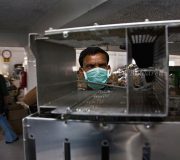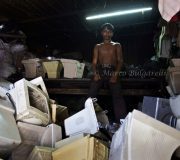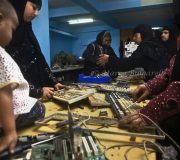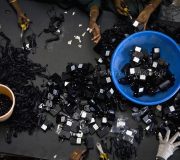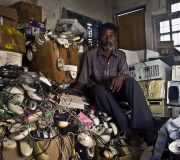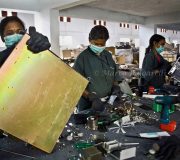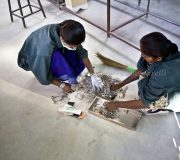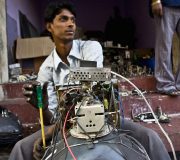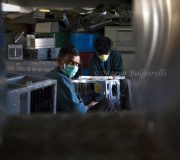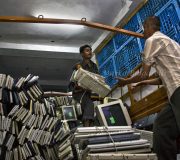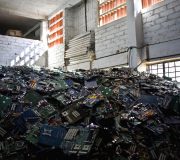E-waste India
Bangalore, the Silicon Valley of the Indian subcontinent, the showcase for India’s high-tech industry, a paradise of Western outsourcing, and the epicenter of Indian development, is an “ecological time bomb” ready to explode. The capital of Karnataka is the new landfill for the IT waste of the nation and the world. It is a complex business, which rests upon a thriving underground economic system, to the detriment of humans and the environment. In the city’s suburbs an army of improvised recyclers, often children, dismantles electronic components and extracts from them tiny amounts precious metals such as platinum, silver, and gold. They use acids with their bare hands, thus coming into contact with harmful substances such as lead, cadmium, mercury. Whatever cannot be recycled, is dumped in the ground and seeps into the aquifers.
Following the introduction in China - once the primary destination of e-waste - of stricter rules on the import of electronic garbage, the trade routes of recyclable microchips moved toward the Indian subcontinent. Soon the alarm bells started to sound. The Government of India, however, unlike China, has not yet passed any specific regulation on the treatment of electronic waste. Nor is the issue currently on the agenda.
But Bangalore has its own identity, which it has been toiling to build: that of cutting-edge laboratory for new plants to recycle and recover e-waste in an environmentally friendly way. The city is a sprawling metropolis of 6 million souls. On its own it produces each year 12,000 tons of tech waste, 1,000 tons of plastic, 300 tons of lead, 43 tons of nickel, 350 tons of copper and 230 kilos of mercury. There are over 300 small companies involved in the extraction of plastic, glass and metals from computers and other electronic equipment thrown into landfills. In India the largest source of e-waste comes from the government offices and public and private industry, which alone contribute 70% of all electronic garbage (in 2007, about 330,000 tons). Individual citizens generate only 15% of the total. But the heaps of discarded computers and mobile phones dumped in improvised landfills (and hard to count), are being raised mainly by the industrialized world where “recycling” is tantamount to “dumping abroad”. Despite being banned in India, the flow of toxic waste entering the country is now increasing. International norms, such as the Basel Convention, ratified by India on June 24, 1992, can’t stem the problem. In the last six months of 2007 alone, 600 tons of e-waste entered the country in the form of duty free “donations”, according to Threehugger.com, which specializes in information on the environment. In a single year, India imports 50,000 tons of e-waste, according to a study by the Manufacturers’ Association for Information Technology. According to a report by the Associated Press, 80% of electronic components collected in the U.S. for recycling are sent abroad. And Asia is the most popular destination. The export from the United States cannot be considered illegal because the U.S. is the only industrialized nation which has not ratified the Basel Convention, the Treaty which bans the sell of toxic waste to developing countries. The Indian NGO Toxics Link has calculated that to dispose of an obsolete computer in the United States costs about US$20. Instead of asking for money to take this waste, the Indians are willing to pay up to US$15 to bring it over to the subcontinent. The result is a net gain of US$35 for America and US$10 for Asia, from components and materials sold. “China, at least, has started to curb imports,” - says Ravi Agarwal, director of Toxics Link. “At this rate India is destined to become the landfill of the developed world.” The regulation of these activities is difficult, especially because a large black market for second-hand electronic goods is an outlet for the waste. And the legislative vacuum means that almost 99% of the processing of e-waste is in the hands of an unregulated shadow economy. This informal sector, where no proper legal or contractual rules apply, is concentrated in cities like Delhi and Calcutta, which receive most of the containers full of e-garbage that land in Madras and Bombay.
It would seem to be an irreversible situation, an impenetrable “Far West” with no laws, but it’s precisely in Bangalore that something has started to move. To date this is the only Indian city, besides Chennai, which is attempting to step out of the jungle into a some kind of order. So far, two companies are in fact operating with government approval: the E-Parisaraa, authorized by the Central Pollution Control Board (CPCB) and Ash Recyclers, authorized by the Karnataka State Pollution Control Board (KSPCB), a public body. In Chennai, however, only Trishyiraya operates, under license by the CPCB. Founded in 2005 by a chemical engineer, P. Parathasarathy, E-Parisaraa works in compliance with strict safety standards. The staff wears special eye-protecting goggles and face masks against acid fumes. The electronic garbage is collected and taken to the Dobbespet unit, 47km from Bangalore, where it is dissected. Some of the extracted materials are sold, other sent to be recycled, still others are shipped to Belgium, where the recovery techniques are the best in the world. The processor of a computer contains 50 to 56 mg of gold and a motherboard has from 150 to 200 mg. “We are now aiming for a 99% recycling rate, with 1% of loss. For now we’ve reached 91% and that is a good result,” Parathasarathy told the newspaper The Hindu. With the help of European experts, the E-Parisaraa, which is part of a national task force, is preparing guidelines for a draft law on e-waste to be submitted to the government. It also organizes workshops to sensitize operators on the environmental risks. Launched by a former trader of waste, Syed Hussain, Ash Recyclers won KSPCB’s stamp of approval in 2006. Unlike the E-Parisaraa, which is has a focus on recycling, Ash Recyclers is centered on the re-utilization of computer components. The company buys obsolete machines for about 12 rupees (about 0.17 euros) per Kg, extracts the reusable parts and re-assembles them into computers to sell them as second-hand goods with a of 600% profit margin.
But the obstacles that these new “green” companies encounter are many. In addition to overcoming problems of a technical nature – for the most part a lack of advanced equipment - paradoxically the greatest difficulty is recovering trashed electrical and electronic components, mostly captured by the unregulated sector. In total, the three legally authorized companies, manage to recycle every year only about 1,000 of 330,000 tons of e-waste produced by the Union, according to data relating to 2007. This year E-Parisaraa was able to treat only one ton of electronic waste per day. The goal is to reach at least 10 tons per day, and to this end the cooperation of major IT companies is vitally important. The E-Parisaraa has agreements with IBM, HP, ABB to ensure delivery of their waste.
At present the model to which we look with great expectations is that of Ash Recyclers. The NGOs engaged in the field argue, in fact, that “re-utilization” is more applicable and effective in the Indian context than “recycling”. According to Wilma Rodrigues of Saahas, a non-governmental organization in Bangalore, “re-utilization is the best option and may also serve to bring the technology to those who cannot afford the latest equipment.” For this model to pick up, it is vital to regulate the informal shadow sector, which already has the necessary equipment and skills, thanks to long experience in the field. The starting point is to educate the poor and illiterate, which swell the ranks of the unregulated sector, on the larger profits to be gained by the re-utilization of electronic components, rather than from the resale of precious metals and to raise awareness of the risks that the current methods entail for their health. One effort at this level has been done by the German NGO, “GTZ” in the infamous area of Gowripalya of Bangalore, once a feud of illegal recyclers. Here the company E-Waard was formed, which is operating the gradual transition from polluting practices and recycling of hazardous-waste. With the work of disassembling and selling of reusable components a family earns about 4,000 rupees per month, enough for its livelihood. Several pilot projects are also aimed at raising awareness. In Bangalore, the Indian government in cooperation with the German and Swiss under headline Indo-German-Swiss E-Waste Initiatives gave birth in 2005 to the E-Waste Agency (EWA), a think tank designed to study strategies that improve the management of electronic trash. Still three years ago, the Karnataka State Pollution Board contacted the multinationals present in the state capital – such as Ibm and the Indian Infosys and Wipro - to involve them in a door-to-door public awareness campaign. A list of polluting high-tech companies has been compiled. Gradually in Bangalore a greater awareness seems to be spreading, environmentalists suggests, for the need for all stakeholders to cooperate in the cycle of “creation and use” of a machine. From high tech multinationals, which should take responsibility for what they produce, remove hazardous substances from their products and stop downloading to India what the West does not need; up and down to the masses of dispossessed Indians who by this business draw their only source of livelihood, without being able to afford the luxury of thinking about their health and the environment.
BOX
According to data from the Manufacturers’ Association for Information Technology, in 2011, the second most populated nation in the world produce 470,000 tons of e-waste. Electronic waste (WEEE, Waste Electrical and Electronic Equipment) is said to be any electrical or electronic equipment abandoned because failed or obsolete. It is divided into three categories: “grey” (monitors, computers, printers, faxes), “white” (refrigerators, washing machines and dishwashers) and “brown” (hi-fi equipment, telephones, cameras and TV). WEEEs are considered toxic due to the substances released during treatment. The electronic market in India will amount to $363 billion by 2015, from $30 billion currently, according to estimates made by the India Semiconductor Association of Bangalore. The increase in individual income in an economy with an annual growth rate above 8% and strong competition which has led to a drastic fall in prices has generated a solid middle class (300 million people) who are consumers of new technologies. The field of electrical and electronic components in India will increase by 29.8% from 2005 to 2015. The Union has the best market in the world for mobile phones: in 2007, 93 million units were sold.
Purchases of computers grew by about 400% over the last six years. The mountains of obsolete electronic products has been rising at a high rate, due to the rapid development of the sector and an increasingly short life cycle. Only in Bangalore, every year 30,000 computers, considered to be “outdated”, are abandoned. The so-called hidden flow of e-waste, which is fed by the unscrupulous in the West, is impossible to quantify. In the European Union, WEEE is estimated at 8.7 million tons per year, while the recovered and treated waste amounts to approximately 2.1 million tons. The remaining 6.6 million tons take the route to Asia.
MARTA ALLEVATO


